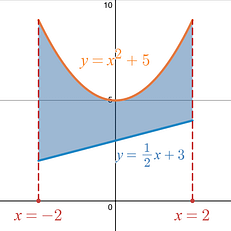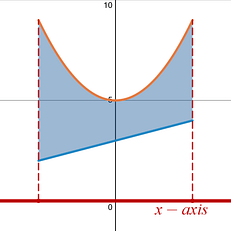Example 1: Washer Method About the x-axis
|
Find the volume of the solid generated by revolving the region bounded by the curves about the x-axis. |
|
|
Step 1: Draw out the region that you are being asked to rotate .
In this example you have the curve , which is a parabola shifted up two units, the curve , which is a linear equation with a y-intercept of 3 and a slope of 3. You close off the region on the lefthand and righthand sides using the curves, .
The region that you are being asked to rotate is the shaded region.
|
|
|
Step 2: Determine the axis you are begin asked to revolve or rotate your region around.
In this problem the language says, “about the x-axis ”. You are revolving around the x-axis . |
|
|
Step 3: Determine whether your equation is in terms of x (standard: ) or in terms of y (non-standard: ).
Since you are asked to revolve around the x-axis you know that this is a horizontal axis , and you want to setup your Disk Methodintegral in terms of x .
The given equations , and are ready to use because it is already in terms of x . |
|
|
Step 4: Determine the bounds of the integral, , for each of your enclosed regions.
This problem gives your bounds in the form of the two additional equations, , that close the region on the lefthand and righthand sides. The lower bound will be a = -2 , and the upper bound of your integral will be b = 2 . |
|
|
Step 5: Determine your radius equations, the Outer radius , R(x) , and the Inner radius , r(x) .
I find it helpful to draw the two radiuses. Start on the axis of rotation you are provided, and draw a line towards the region that you drew in Step 1 .
Since you are rotating around the standard x-axis , start on the x-axis , and draw up. The graph that you run into first is your Inner radius , r(x) , and the graph that you run into second is your Outer radius , R(x) .
Here the first curve you run into is , and the second curve you would run into would be . |
|
|
Step 6: Setup and evaluate your Washer Methodintegral.
|
– Bounds from Step 4 : – Equations from Step 5 :
|
|
The volume of the solid obtained by rotating the region bounded by the curves about the x-axis is .
|
|












